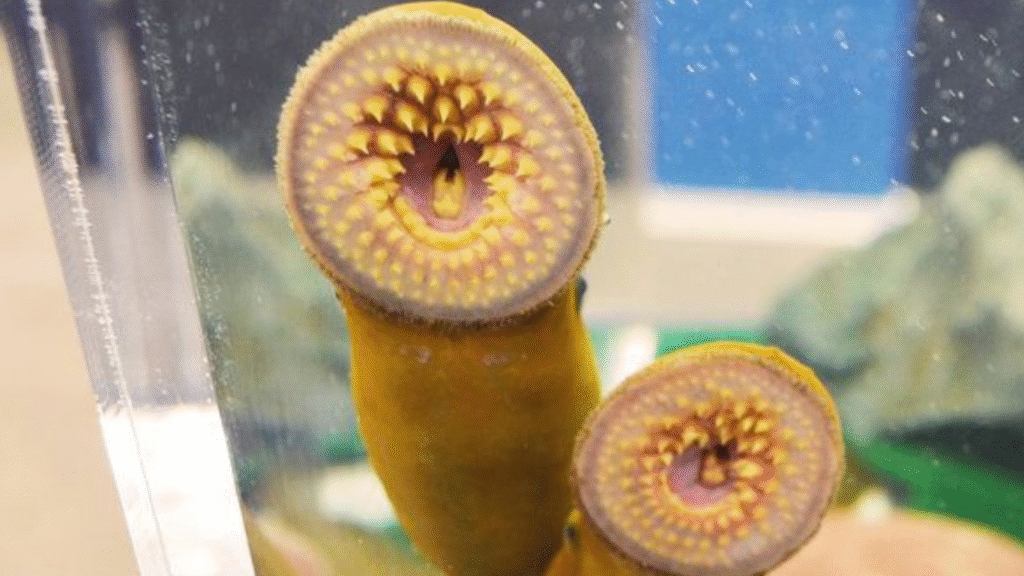Lamprey: Nature’s Ancient Marvel
Lampreys are fascinating creatures that have swum through Earth’s waters for over 360 million years, long before the first dinosaurs appeared. Often mistaken for eels because of their long, slender bodies, lampreys are actually a unique group of jawless fish, belonging to the order Petromyzontiformes. Their primitive appearance and unusual lifestyle make them one of nature’s most intriguing animals.

What is a Lamprey?
Lampreys are characterized by their circular, sucker-like mouths filled with rows of sharp, keratinized teeth. Unlike most modern fish, they do not have jaws. Instead, lampreys latch onto other fish, scraping away flesh and feeding on their host’s blood and bodily fluids. This parasitic behavior is seen in many species, though not all lampreys are parasitic; some live quiet, non-feeding lives after their larval stage.
Key Features of Lampreys:
- Jawless mouth with a powerful suction disc
- Cartilaginous skeleton (no bones)
- Seven pairs of gill openings
- Eel-like body without paired fins
- Primitive vertebrate features, offering insights into early animal evolution
Where Do Lampreys Live?
Lampreys inhabit both freshwater and saltwater environments. They are found in North America, Europe, Asia, and Australia. Most lamprey species spawn in freshwater rivers and streams, where their larvae, called ammocoetes, burrow into soft sediment and filter-feed for several years before metamorphosing into adults.
Some lampreys migrate between fresh and saltwater (anadromous species), similar to salmon. One of the most infamous species, the sea lamprey (Petromyzon marinus), has caused ecological havoc in the Great Lakes of North America by decimating native fish populations.
Lamprey’s Role in Ecosystems
Although lampreys are often seen as pests, they play an important role in aquatic ecosystems. Their larvae help maintain riverbeds by filtering organic matter, contributing to the overall health of their environment. Additionally, adult lampreys provide food for birds, fish, and mammals, making them a crucial part of the food web.
In regions where lampreys are native, they are considered a vital species. However, in places where they are invasive, such as the Great Lakes, they have led to major efforts in control and management.
Are Lampreys Dangerous to Humans?
Lampreys generally do not pose a threat to humans. While their toothy mouths may look fearsome, attacks on people are extremely rare. Most lampreys prefer their traditional fish hosts and are not interested in humans.
However, in historical times, lampreys had a strong cultural significance. They were considered a delicacy by ancient Romans and medieval Europeans. King Henry I of England was even said to have died from eating too many lampreys!
Conservation Status
Today, many lamprey species face threats from habitat destruction, pollution, and the construction of dams that block their spawning migrations. Conservation efforts are underway to protect native lamprey populations and to restore the ecosystems they inhabit.
Organizations around the world are working to improve river connectivity, control invasive populations, and educate the public about the ecological importance of these ancient fish.
Fun Facts About Lampreys
- Lampreys have no true bones—their skeletons are made of cartilage.
- Some lamprey species grow up to 3 feet long!
- Lamprey larvae can live up to 7 years before becoming adults.
- Their fossils show little change over millions of years, earning them the nickname “living fossils.”
Conclusion
Lampreys may not be the most glamorous creatures, but they are living windows into Earth’s distant past. Their resilience, unique biology, and ecological importance make them a true marvel of nature. Whether you find them fascinating or fearsome, lampreys are undeniably one of the world’s most extraordinary animals.








